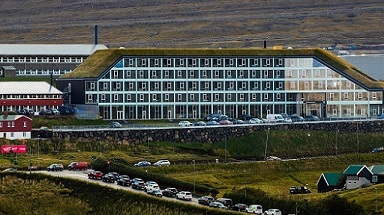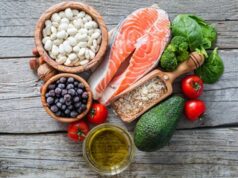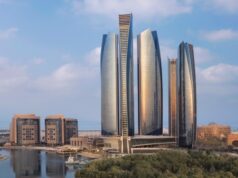FAROE ISLANDS—For those of you not familiar with their location, the Faroe Islands are a North Atlantic archipelago located 200 miles north-northwest of Scotland, and about halfway between Norway and Iceland. Like Greenland, it is an autonomous territory within the Kingdom of Denmark. Last October, the 130-room Hilton Garden Inn Faroe Islands opened on the islands in Torshavn with a bundle of unique green features. Green Lodging News recently corresponded with Kate Mikesell, VP Corporate Responsibility, Hilton, and Martin Restorff, General Manager of the hotel, to learn about those green gems.
For Kate Mikesell, VP Corporate Responsibility, Hilton:
Q: Explain how the heating system works. The power plant sends over electricity. Or, actual heated air?
 A: As part of our Travel with Purpose 2030 Goals, Hilton is committed to reducing carbon emissions by 61 percent, in line with the Paris Climate Agreement. For this hotel specifically, we can make progress toward that goal by getting the energy for the heating system from the local powerplant. The plant captures leftover energy from a range of industries, including turning waste from the Islands’ thriving salmon fishing industry into energy. This energy is used to power the hotel’s heating system.
A: As part of our Travel with Purpose 2030 Goals, Hilton is committed to reducing carbon emissions by 61 percent, in line with the Paris Climate Agreement. For this hotel specifically, we can make progress toward that goal by getting the energy for the heating system from the local powerplant. The plant captures leftover energy from a range of industries, including turning waste from the Islands’ thriving salmon fishing industry into energy. This energy is used to power the hotel’s heating system.
Electricity for the hotel is sourced from national supplier SEV. SEV seeks to use as much green energy as possible, capitalizing on the windy climate of the Faroe Islands—and the fairly regular supply of rainfall. On particularly wet and windy days, the country’s energy supply is almost 100 percent green. SEV shares a daily tracker on its website so anyone can see what proportion of energy is being captured from renewable sources on any given day.
Q: The hotel appears to have a green roof. I would like to learn more about it. Is it just grass? Other plants? To what degree does it contribute to the energy efficiency of the building? To what extent did it add to the hotel’s cost?
A: The hotel’s roof is covered in grass from local land, blending the hotel into the scenery. This green roof provides multiple environmental benefits including insulating the building (reducing heating requirements), improving stormwater management, providing erosion protection, and contributing to biodiversity. Local stone was also used for the structure of the hotel.
Q: What else is “green” about the hotel? What is done to reduce the amount of waste generated? Is there recycling? Composting?
A: Hilton Garden Inn Faroe Islands is a fantastic example of how a property can be built with sustainability at its core. The property incorporates features such as ultra-efficient heating, ventilation, and renewable energy systems, and efficiency-focused technologies to reduce energy and water consumption. This new hotel will allow international travelers to responsibly experience this incredible destination, and its focus on sustainability closely aligns with the archipelago’s own sustainable tourism strategy.
To give some examples, carbon emissions, water and waste are three elements which were carefully considered during the development of the hotel, mirroring our Travel with Purpose 2030 Goals. There are numerous examples, covering everything from the basics of LED and motion-sensor lighting and recycling bins in guestrooms, to employing advanced building management systems that optimize the energy efficiency of the heating and ventilation systems.
Each element of the operations and guest experience has been designed by employing technologies and systems that put sustainability front and center. Our guests will see bulk soap dispensers that reduce plastic waste and motion-sensor taps in their rooms. We are even installing the islands’ first electric car charging station for their use. And while they will never see it, guests can also rest easy that the property is running on renewable energy from the local power plant, utilizing underfloor heating to further conserve energy, and constantly monitoring its operations to ensure any issues that might be wasteful are immediately addressed.
Hilton is also very committed to driving responsible sourcing. In line with our 2030 Goal to double our sourcing from local and sustainable businesses, the hotel plays a crucial role in supporting local industry. Most of the hotel’s meat, fish and vegetables are sourced from local suppliers, which also helps to reduce reliance on imported goods.
All of our properties around the world are required to continuously monitor their environmental and social impact using our proprietary, cloud-based corporate responsibility management tool, LightStay. In LightStay, each hotel’s performance is tracked against energy/carbon, water and waste reduction goals that align with our 2030 Goals, and hotels are also required to demonstrate implementation of improvement projects to ensure their footprint is consistently reduced over time. Hotels’ LightStay performance data is visible to guests via the hotels’ Wi-Fi landing page, so they can also look at the property’s progress if they wish to do so.
For Martin Restorff, General Manager of the Hotel:
Q: I am curious to know about the food ingredients sourced from local suppliers. And, what are polytunnels?
A: The climate and soil of the Faroe Islands do not lend well to agriculture, so to ensure the best possible supply of locally sourced fruit and vegetables, many crops are grown using polytunnels. Polytunnels work in a similar way to a greenhouse, creating a microclimate that provides the higher temperatures and humidity required to grow crops.
This type of farming is a great way to ensure as much food as possible is grown and sourced locally, which also helps to limit the amount of goods imported onto the islands. Without this farming solution, most of the fresh fruit and vegetables would need to be imported by the hotel.
The project from which the hotel sources its fruit and vegetables sits on one of the 18 islands in the Faroe Islands, and the site is carefully monitored to ensure there is no negative impact on the terrain.
Globally, Hilton has a goal to reduce produced waste, including food waste, by 50 percent by 2030, so this is a key priority for all of our hotels. Jákup Sumberg, the Head Chef at the hotel’s restaurant Hallartun, is passionate about supporting this goal. Mindful of how important this is, he works hard to minimize food waste as far as possible through careful planning and repurposing surplus ingredients into new dishes.
Q: To what degree is the hotel’s sustainable features used in the marketing of the property?

A: The Faroe Islands has its own sustainable tourism strategy, and as a hotel we are passionate about our role in supporting this critical agenda, which is why the hotel was built with sustainability at its core.
As with all Hilton properties, guests with an active interest in sustainability and community impact can view the property’s LightStay performance data via our Wi-Fi landing page. This is a great way to demonstrate to guests the tangible impact of the hotel’s actions to reduce environmental footprint as far as possible.
Restaurant Hallartún is founded upon seasonality and local sourcing, both of which are important considerations in line with Hilton’s Travel with Purpose 2030 Goals. This is a real draw for guests and something that we promote heavily. As well as a range of classic dishes, the restaurant has a dynamic menu which changes regularly, focusing on showcasing the best seasonal fish, meat and vegetables.
Q: How has business been since the hotel’s opening? Has there been much COVID-19 infection on the Islands? What has the hotel done to ensure a high level of hygiene/cleanliness—while keeping sustainability in mind?
A: The Faroe Islands has mandatory pre-travel testing, testing and self-isolation upon arrival, and a second test six days after arrival. These measures mean we have been able to live quite normally on the islands, with limited cases.
At the hotel, hygiene and cleanliness are a top priority. Hilton Garden Inn Faroe Islands features Hilton CleanStay, designed to deliver an industry-leading standard of cleanliness and disinfection across Hilton’s hotels globally. The program allows our guests to enjoy an even cleaner and safer stay, providing peace of mind from check-in to check-out. We continue to focus on protecting the health and wellbeing of guests and Team Members—and are doing so in the most sustainable way possible.
Given the current limits on international travel, we have had a unique opportunity to spend time integrating into the local community. Since opening, we have thoroughly enjoyed welcoming locals to the hotel to show everything we have to offer—and we have been busy! As the first internationally branded hotel on the islands, Hilton Garden Inn Faroe Islands has created a real buzz in the community, and it has been great to be able to host so many locals for short breaks and dinners at our restaurant.
That said, we are very much looking forward to welcoming international guests to the hotel so they can experience these unique islands as soon as possible.







